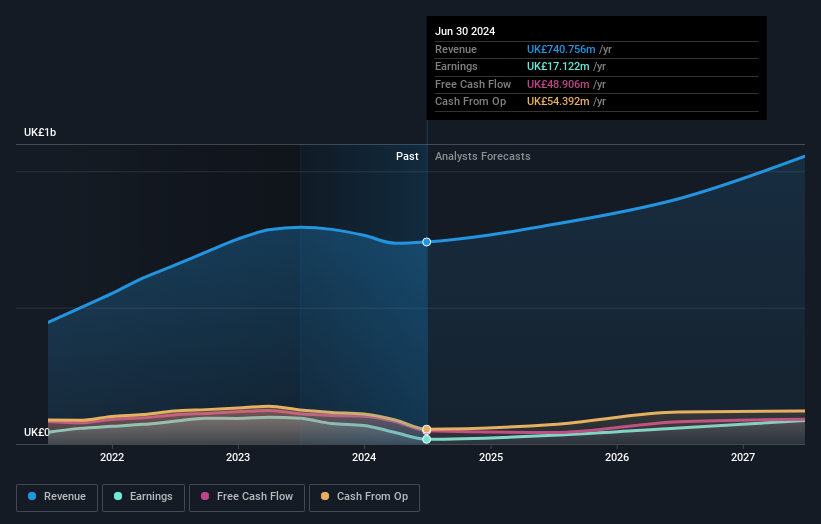One of the biggest stories of last week was how Endava plc (NYSE:DAVA) shares plunged 20% in the week since its latest yearly results, closing yesterday at US$26.62. It looks like a pretty bad result, all things considered. Although revenues of UK£741m were in line with analyst predictions, statutory earnings fell badly short, missing estimates by 32% to hit UK£0.29 per share. Earnings are an important time for investors, as they can track a company's performance, look at what the analysts are forecasting for next year, and see if there's been a change in sentiment towards the company. So we collected the latest post-earnings statutory consensus estimates to see what could be in store for next year.
Check out our latest analysis for Endava

Taking into account the latest results, the current consensus from Endava's twelve analysts is for revenues of UK£804.6m in 2025. This would reflect a solid 8.6% increase on its revenue over the past 12 months. Statutory earnings per share are predicted to surge 33% to UK£0.38. Yet prior to the latest earnings, the analysts had been anticipated revenues of UK£820.9m and earnings per share (EPS) of UK£0.60 in 2025. So there's definitely been a decline in sentiment after the latest results, noting the pretty serious reduction to new EPS forecasts.
The average price target fell 11% to US$40.57, with reduced earnings forecasts clearly tied to a lower valuation estimate. There's another way to think about price targets though, and that's to look at the range of price targets put forward by analysts, because a wide range of estimates could suggest a diverse view on possible outcomes for the business. There are some variant perceptions on Endava, with the most bullish analyst valuing it at US$64.87 and the most bearish at US$30.10 per share. So we wouldn't be assigning too much credibility to analyst price targets in this case, because there are clearly some widely different views on what kind of performance this business can generate. With this in mind, we wouldn't rely too heavily the consensus price target, as it is just an average and analysts clearly have some deeply divergent views on the business.
These estimates are interesting, but it can be useful to paint some more broad strokes when seeing how forecasts compare, both to the Endava's past performance and to peers in the same industry. It's pretty clear that there is an expectation that Endava's revenue growth will slow down substantially, with revenues to the end of 2025 expected to display 8.6% growth on an annualised basis. This is compared to a historical growth rate of 22% over the past five years. Juxtapose this against the other companies in the industry with analyst coverage, which are forecast to grow their revenues (in aggregate) 8.9% annually. So it's pretty clear that, while Endava's revenue growth is expected to slow, it's expected to grow roughly in line with the industry.
The Bottom Line
The biggest concern is that the analysts reduced their earnings per share estimates, suggesting business headwinds could lay ahead for Endava. They also reconfirmed their revenue estimates, with the company predicted to grow at about the same rate as the wider industry. Furthermore, the analysts also cut their price targets, suggesting that the latest news has led to greater pessimism about the intrinsic value of the business.
With that in mind, we wouldn't be too quick to come to a conclusion on Endava. Long-term earnings power is much more important than next year's profits. We have forecasts for Endava going out to 2027, and you can see them free on our platform here.
Don't forget that there may still be risks. For instance, we've identified 2 warning signs for Endava that you should be aware of.
Valuation is complex, but we're here to simplify it.
Discover if Endava might be undervalued or overvalued with our detailed analysis, featuring fair value estimates, potential risks, dividends, insider trades, and its financial condition.
Access Free AnalysisHave feedback on this article? Concerned about the content? Get in touch with us directly. Alternatively, email editorial-team (at) simplywallst.com.
This article by Simply Wall St is general in nature. We provide commentary based on historical data and analyst forecasts only using an unbiased methodology and our articles are not intended to be financial advice. It does not constitute a recommendation to buy or sell any stock, and does not take account of your objectives, or your financial situation. We aim to bring you long-term focused analysis driven by fundamental data. Note that our analysis may not factor in the latest price-sensitive company announcements or qualitative material. Simply Wall St has no position in any stocks mentioned.
About NYSE:DAVA
Endava
Provides technology services in North America, Europe, the United Kingdom, and internationally.
Undervalued with proven track record.
Similar Companies
Market Insights
Community Narratives


Recently Updated Narratives


No miracle in sight


Q3 Outlook modestly optimistic


Alphabet: The Under-appreciated Compounder Hiding in Plain Sight
Popular Narratives


The company that turned a verb into a global necessity and basically runs the modern internet, digital ads, smartphones, maps, and AI.


MicroVision will explode future revenue by 380.37% with a vision towards success



